The Mothers' Hospital of the Salvation Army
153-156 Lower Clapton Rd, Hackney, E5 8EN
Medical dates:
Medical character:
1913 - 1986
Maternity
In 1889 the Salvation Army opened a rescue and maternity home for poor young women in Ivy House, 271 Mare Street, Hackney, many of whom were pregnant but unmarried - a state that carried great social stigma then (maternity hospitals would only admit married women).
By the beginning of the 20th century the accommodation at Ivy House had become inadequate due to the demands upon it, and the Salvation Army eventually bought a 2.75 acre site in Lower Clapton Road to build a new maternity hospital for unmarried mothers. The foundation stone was laid on 4th July 1912 by Princess Louise, Duchess of Argyll.
In the following year Princess Louise, accompanied by the Duke of Argyll, returned again on St Luke's Day (18th October) to officially open the Mothers' Hospital.
The Hospital had 48 beds, but it was intended that it would eventually have 100 beds when the money could be raised (the initial scheme had cost £26,000, but it was estimated that £60,000 was needed for the complete project).
The Hospital's frontage was rather unusual, consisting as it did of six semi-detached houses built in 1824. They were linked together by two distinctive arches giving access to the ward buildings behind, which had been erected in the gardens of the houses. The central house between the two arches bore the legend 'The Salvation Army: The Mothers' Hospital' in large lettering. The houses were used for offices, reception rooms and nurses' quarters.
Behind the central block, one passed down the colonnade and through the administration block to reach the hospital proper.
The wards were housed in four single-storey buildings, which lay on a north-south axis so that they would benefit from any sunshine during most of the day. These bungalows were connected by a colonnade to the entrance building. In fine weather the open colonnades enabled the mothers to sit in the sunshine to nurse their babies.
Each ward block contained a delivery room, a 6-bedded, a 4-bedded and a 2-bedded ward, a ward kitchen and bathroom facilities. In each ward was a portrait of the late General Booth and his wife. The ward floors were of Canadian maple wood, with the walls painted either a pleasant shade of green or salmon colour. Beside each bed was a cot with dimity curtains and a pure white quilt. Each ward, in addition to numerous windows, had French windows opening up to the lawns surrounding the bungalows.
The labour room had a tesselated floor and was equipped with all modern conveniences; a sterilizer, hot and cold water laid on over large basins and a convenient labour bed of a suitable height. The latter was fitted with a zinc foundation (to prevent sagging), which let down below the level of the framework so that the mattress would not slip. The whole was covered with a large red rubber mackintosh. A fitting at the end of the bed enabled a pulley to be attached and, on the right of the footpiece, an enamelled post with hooks at different heights for the douche can.
In addition to the wards there was a separate isolation block in a corner of the grounds, where a patient and two nurses could be kept apart. Between the buildings small gardens were set out, with trees, shrubs and flowerbeds, and an ornamental garden at the Clarence Road end of the site.
It was proposed to designate one bungalow for unmarried mothers, while another was reserved exclusively for poor married women. Another would be used for special cases and, it was hoped, one would be used by Jewish mothers.
All the Sisters, as well as the Matron, were officers in the Salvation Army. Their uniform was a pale buff-coloured dress, with apron and handkerchief cap. On the collar of the dress was a red tab bearing a badge denoting the rank of the officer.
During WW1 the Hospital began to care for the large number of pregnant women who had been widowed and had subsequently become destitute, specifically those whose husbands had been in the Army or Navy. The Management Committee then decided it would permit women whose husbands were serving in the forces to be admitted. After the war, there was no discrimination and all mothers, whether married or not, were admitted.
In 1921, when the Hospital had 72 beds, a new Nurses' Home was opened by Queen Mary. The ground floor of the Home contained a Dining Room and servery, and a comfortably furnished common room. The two floors above each had 14 bedrooms opening onto a connecting corridor. The rooms were painted pale green with curtains of a deeper shade. Each room contained a bed, a wicker armchair, a chest of drawers, a hanging wardrobe and a marble-topped washstand. Each floor contained bathrooms and annexes.
By this time, two of the ward blocks were used for married women, one for unmarried and one for convalescents. All the wards, except the 2-bedded ones, had French windows opening on to the garden.
By the 1930s the annual number of births had risen to 2,000, a great increase from the original number of 600 that the Hospital had been built for. The Hospital Committee was unhappy with the frontage of the Hospital, and continually tried to raise funds so that the Victorian houses could be demolished and a 5-storey building erected in their place. This scheme was never realized, however.
In 1934 an Out-Patients Department opened for ante- and post-natal patients. In June 1937 a new Isolation Block was added at a cost of £8,111. Its 12 single rooms were equipped with balconies, and the building also contained two nurseries and up-to-date kitchens and bathrooms.
During WW2 the patients, together with the Midwives Training School, were evacuated to Willersley Castle in near Matlock in Derbyshire, or to Bragborough Hall in Northamptonshire, both of which had been commandeered by the Ministry of Health. However, the Hospital was allowed to remain open for those patients who did not want to leave London, on condition that an adequate air-raid shelter was built to accommodate both patients and staff (the Hospital's single-storey design made it vulnerable to bomb damage). Work began on the tunnel shelter, but in the meantime the walls of the wards were strengthened with steel girders and the windows obscured by blast walls. Until the shelter could be completed, the patients had to remain in their wards during bombing raids, singing hymns to keep their spirits up. The shelter was completed in October 1940. Instead of spending the usual prescribed ten days in bed following giving birth, mothers were encouraged to be mobile by the second day so that they could walk to the air-raid shelter rather than having to be transported there in their beds. Patients who had undergone Caesarean section were allowed up on the fifth day. This practice of mobilising patients early had unexpected health benefits, with less morbidity, marked reduction in the rate of venous thrombosis and improved involution (reduction of the uterus to normal size). Once dusk fell, patients moved to the shelter to spend the night there, regardless of whether there was an air-raid or not. They took their babies, gas masks, coats and a spare blanket with them. Those unable to walk were wheeled there in chairs or stretchers. On a typical night there would be 3 stretcher cases and 8 wheelchair users; it took about 7 minutes to get everyone into the shelter. The only patients allowed to remain in the Hospital were those in labour - in a specially reinforced Labour Room.
In September 1940 the Hospital received a direct hit from a bomb, but fortunately there were no casualties. Two of the ward blocks were destroyed, reducing the bed complement to 50.
Throughout the war the District Midwives continued to make home visits, despite the black-out and in spite of on-going air-raids.
After the war the strict visiting hours were relaxed, and the single visiting hour from 18.00 hr to 19.00 hr was extended to make it easier for servicemen on leave or munition workers on shifts to visit their wives and babies. The number of young unmarried mothers had increased during the war and the Hospital was acutely short of space. The damaged ward blocks were reopened in 1946.
The Hospital became part of the NHS in 1948, under the administration of the Hackney Group Hospital Management Committee, part of the North East Metropolitan Regional Hospital Board. The legend on the Lower Clapton Road frontage was changed to 'The Mothers' Hospital (Salvation Army)'. Salvation Army members were still welcomed on the staff, and this relationship between the NHS and Salvation Army continued until closure of the Hospital.
In 1952 Lorne House, at 126-128 Lower Clapton Road, was
converted for use as a Nurses' Home with 24 rooms, and a Training
Centre. At this time, a 'home birth' service was established.
In 1974, following a major reorganisation of the NHS, the
Hospital came under the control of the City and Hackney Health
Authority, part of the North East Thames Regional Health Authority.
All maternity and obstetric services moved to a new unit at the newly
opened Homerton Hospital in
1986.
|
Present status
(December 2007) |
|---|
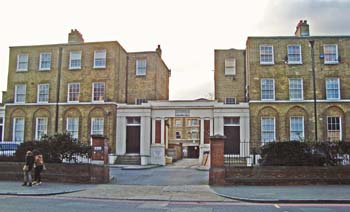
The house shown on the left was the central building which bore the legend 'The Mothers' Hospital (Salvation Army) on its frontage. The 3-storey houses are off-set from Lower Clapton Road and were Grade II listed in 1975 as 145-153 Lower Clapton Road (1-7 Maitland Place). The Hospital was originally at Nos. 153-163 but, following renumbering of the road, it was listed at Nos. 143-153.
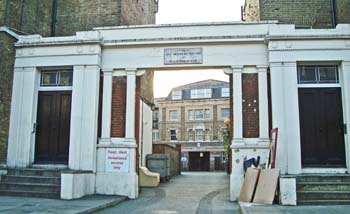
The white archway leading through to Mothers' Square.
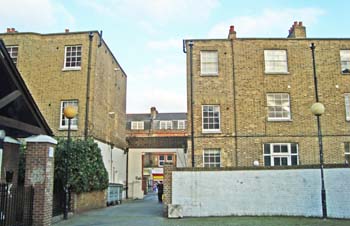
Looking back through the archway towards Lower Clapton Road.
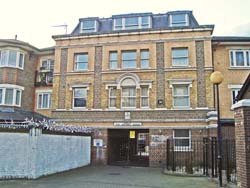
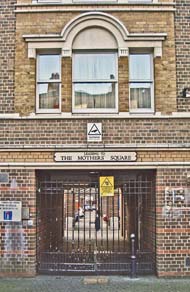
Once through the white archway, an underpass under one of the buildings leads to Mothers' Square itself.
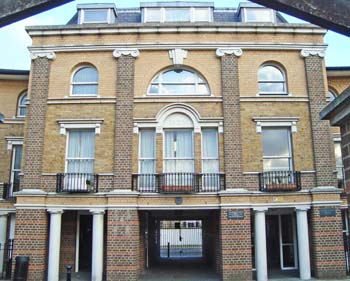
Looking back at the underpass from the far side, a plaque confirms an architectural award for Mothers' Square, and another shows its opening by Prince Charles.
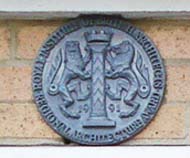

The architectural award is above the gateway (left) and the commemorative plaque on the right-hand pillar (right).
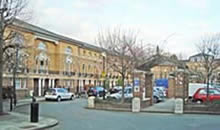

The Mothers' Square. Lilian Karpin House, which provides supported housing for those aged over 55 years, is at Nos. 32-45.
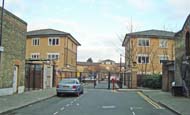
Looking back towards Mothers' Square from Clarence Road.

Maitland Lodge is located within the complex. It has 14 rooms and provides care for adults with learning disabilities and forensic needs. It is managed by Venus Healthcare.
Other 'lost hospitals' in Hackney are the Hackney, the Eastern, St. Leonard's and the German, which were all replaced by the Homerton Hospital.
References
(Author unstated) 1912 The Salvation Army Mothers' Hospital. The Midwife. British Journal of Nursing Supplement, 6th July, 20.
(Author unstated) 1913 The Mothers' Hospital. The Midwife. British Journal of Nursing Supplement, 25th October, 346-348.
(Author unstated) 1914 The work of the Salvation Army Slum Sisters. British Journal of Nursing, 30th May, 490-191.
(Author unstated) 1921 The Queen opens new Nurses' Home of the Salvation Army Mothers' Hospital. The Midwife. British Journal of Nursing Supplement, 11th June, 363.
(Author unstated) 1938 The Mothers' Hospital of the Salvation Army. British Journal of Nursing (June), 101.
http://health.hackneysociety.org (1)
http://health.hackneysociety.org (2)
https://motherandbabyhomes.wordpress.com